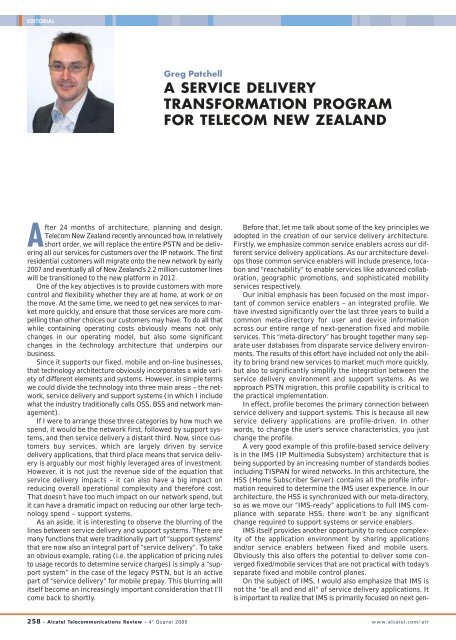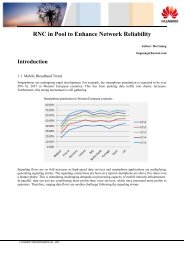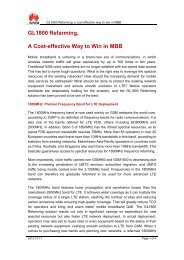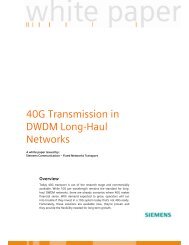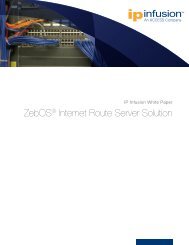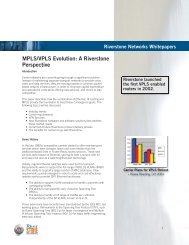report - Light Reading
report - Light Reading
report - Light Reading
You also want an ePaper? Increase the reach of your titles
YUMPU automatically turns print PDFs into web optimized ePapers that Google loves.
EDITORIAL<br />
After 24 months of architecture, planning and design,<br />
Telecom New Zealand recently announced how, in relatively<br />
short order, we will replace the entire PSTN and be delivering<br />
all our services for customers over the IP network. The first<br />
residential customers will migrate onto the new network by early<br />
2007 and eventually all of New Zealand’s 2.2 million customer lines<br />
will be transitioned to the new platform in 2012.<br />
One of the key objectives is to provide customers with more<br />
control and flexibility whether they are at home, at work or on<br />
the move. At the same time, we need to get new services to market<br />
more quickly, and ensure that those services are more compelling<br />
than other choices our customers may have. To do all that<br />
while containing operating costs obviously means not only<br />
changes in our operating model, but also some significant<br />
changes in the technology architecture that underpins our<br />
business.<br />
Since it supports our fixed, mobile and on-line businesses,<br />
that technology architecture obviously incorporates a wide variety<br />
of different elements and systems. However, in simple terms<br />
we could divide the technology into three main areas – the network,<br />
service delivery and support systems (in which I include<br />
what the industry traditionally calls OSS, BSS and network management).<br />
If I were to arrange those three categories by how much we<br />
spend, it would be the network first, followed by support systems,<br />
and then service delivery a distant third. Now, since customers<br />
buy services, which are largely driven by service<br />
delivery applications, that third place means that service delivery<br />
is arguably our most highly leveraged area of investment.<br />
However, it is not just the revenue side of the equation that<br />
service delivery impacts – it can also have a big impact on<br />
reducing overall operational complexity and therefore cost.<br />
That doesn’t have too much impact on our network spend, but<br />
it can have a dramatic impact on reducing our other large technology<br />
spend – support systems.<br />
As an aside, it is interesting to observe the blurring of the<br />
lines between service delivery and support systems. There are<br />
many functions that were traditionally part of “support systems”<br />
that are now also an integral part of “service delivery”. To take<br />
an obvious example, rating (i.e. the application of pricing rules<br />
to usage records to determine service charges) is simply a “support<br />
system” in the case of the legacy PSTN, but is an active<br />
part of “service delivery” for mobile prepay. This blurring will<br />
itself become an increasingly important consideration that I’ll<br />
come back to shortly.<br />
Greg Patchell<br />
A SERVICE DELIVERY<br />
TRANSFORMATION PROGRAM<br />
FOR TELECOM NEW ZEALAND<br />
Before that, let me talk about some of the key principles we<br />
adopted in the creation of our service delivery architecture.<br />
Firstly, we emphasize common service enablers across our different<br />
service delivery applications. As our architecture develops<br />
those common service enablers will include presence, location<br />
and “reachability” to enable services like advanced collaboration,<br />
geographic promotions, and sophisticated mobility<br />
services respectively.<br />
Our initial emphasis has been focused on the most important<br />
of common service enablers – an integrated profile. We<br />
have invested significantly over the last three years to build a<br />
common meta-directory for user and device information<br />
across our entire range of next-generation fixed and mobile<br />
services. This “meta-directory” has brought together many separate<br />
user databases from disparate service delivery environments.<br />
The results of this effort have included not only the ability<br />
to bring brand new services to market much more quickly,<br />
but also to significantly simplify the integration between the<br />
service delivery environment and support systems. As we<br />
approach PSTN migration, this profile capability is critical to<br />
the practical implementation.<br />
In effect, profile becomes the primary connection between<br />
service delivery and support systems. This is because all new<br />
service delivery applications are profile-driven. In other<br />
words, to change the user’s service characteristics, you just<br />
change the profile.<br />
A very good example of this profile-based service delivery<br />
is in the IMS (IP Multimedia Subsystem) architecture that is<br />
being supported by an increasing number of standards bodies<br />
including TISPAN for wired networks. In this architecture, the<br />
HSS (Home Subscriber Server) contains all the profile information<br />
required to determine the IMS user experience. In our<br />
architecture, the HSS is synchronized with our meta-directory,<br />
so as we move our “IMS-ready” applications to full IMS compliance<br />
with separate HSS, there won’t be any significant<br />
change required to support systems or service enablers.<br />
IMS itself provides another opportunity to reduce complexity<br />
of the application environment by sharing applications<br />
and/or service enablers between fixed and mobile users.<br />
Obviously this also offers the potential to deliver some converged<br />
fixed/mobile services that are not practical with today’s<br />
separate fixed and mobile control planes.<br />
On the subject of IMS, I would also emphasize that IMS is<br />
not the “be all and end all” of service delivery applications. It<br />
is important to realize that IMS is primarily focused on next gen-<br />
258 - Alcatel Telecommunications Review - 4 th Quarter 2005 www.alcatel.com/atr


